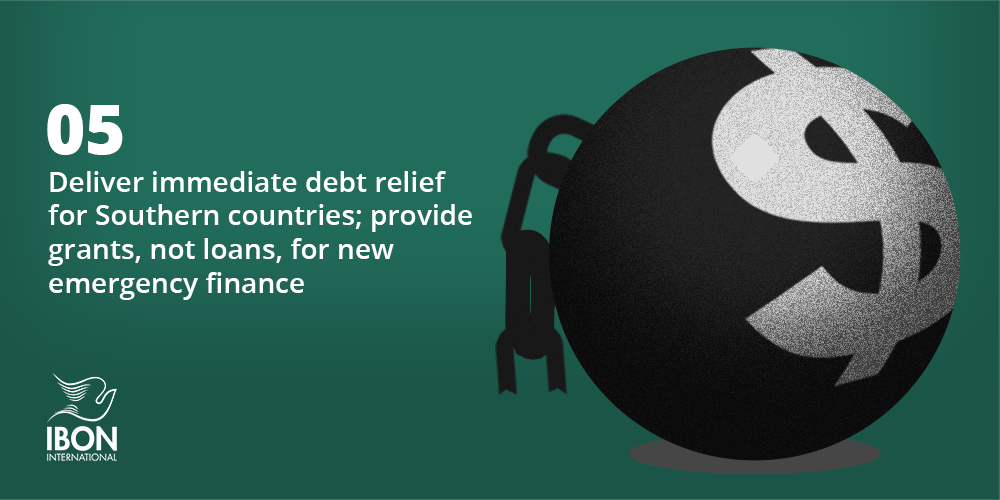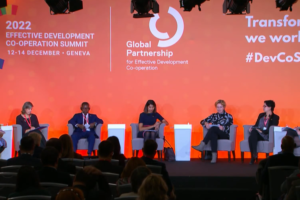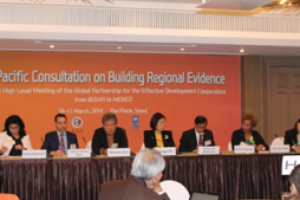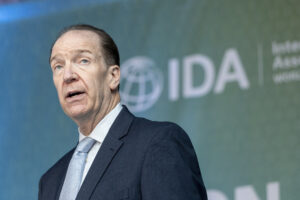Photo: Debt relief is among our Eight Global Action Points in responding to the current world situation.
Current international measures on developing countries’ debts are far from a situation of cancellations from all creditors, longer-term debt cancellations, and certainly far from ending unequal relations with creditor states and capital-holders.
With the onset of the 2020 economic slump, a contraction in the world economy is more than certain. The International Monetary Fund (IMF) claims that it is a situation last seen during the Great Depression, and more recently, describing it as a recession “we have not seen in our lifetimes.”[i] Unemployment and inequalities are expected to increase. More than USD 96 billion of capital exited Southern economies in just months since late-January 2020, more than triple than after the 2008 crisis. Many Southern countries are left with fewer resources to address the pandemic, after decades-long financial integration that tied them to the volatile whims of foreign capital sources. The lingering debt problem is only worsened.
Sounding the alarm on the debt problem
Many have accumulated huge debts especially in the past decade after the 2008 financial crisis, and have struggled to pay these even then—but more so now. The demands of debt payments further drain the pool of money otherwise used for urgent needs, such as emergency responses, social protection measures, and supporting health systems.
In late-2019, 31 countries were already classified by the IMF as under debt distress or high risk (as well as 24 and 14 in moderate and low risk, respectively)—many of which are in Africa. More than USD 369 billion went out for external public debt of low- and middle-income countries in 2018, compared to USD 208 billion in 2008, and far from USD 18 billion in 1977.[ii] The total debt servicing of these countries, including private actors, amounts to more than USD 1 trillion for 2018.
Developing countries are projected to face external public debt servicing in the trillions for 2020 and 2021. This is a “wall of debt service repayments,” according to the UNCTAD, which would amount to between USD 700 billion to USD 1.1 trillion for low- and middle-income countries, and between USD 2 to 2.3 trillion for high-income developing countries, and totalling to an enormous USD 3.4 trillion.[iii] Seventy percent of developing countries are seeing higher government revenues allocated for payments of interest.[iv] Debt servicing is eating up state coffers, from an average of 6.5% of government revenues in 2012 to 10.3% in 2018, and even to the extent of more than 25% in many countries (cases such as Djibouti shows more than 60% of 2018 state revenues used for servicing debts).[v]
In 2018, for every USD 1 of aid received by the South was around USD 2.50 worth of debt payments, of money flowing out. Developing countries are projected to face external public debt servicing in the trillions for 2020 and 2021.
Even prior to the pandemic, countries such as Lebanon, Pakistan and Argentina have already been experiencing debt problems; Zambia, Ecuador have more recently indicated problems in paying.[vi] This is the case while many donor economies have not fulfilled aid commitments worth 0.7% of their Gross National Income (GNI). Comparing just external sovereign debt payments with aid in 2018, for every USD 1 of aid received by the South was around USD 2.50 worth of debt payments, of money flowing out.
For many developing countries, revenues from exports are a way of accumulating foreign reserves to pay debts. Fifty-one of the developing countries under some risk of debt distress by late 2019 are also commodity dependent, or tied to the export of a few kinds of primary goods (agricultural, mineral, and energy products).[vii] Thus situations of lower world commodity prices, such as today, are difficult for raising foreign currency to pay foreign debt. Added to this are other new pressures of a sudden decline in world trade, and the emergency budgetary needs to address the coronavirus disease (COVID-19) pandemic. Worse, the trend of low commodity prices is expected to continue even if the pandemic is addressed, given the overproduction, and “growing stockpiles,” of minerals and metals.[viii]
The debt problem is also an issue of how states tend to pass the debt burden on the shoulders of peoples in the name of “fiscal discipline”. To pay foreign debts, states from Argentina to the Philippines have historically adopted measures of new regressive taxation (e.g., taxes on consumer goods) to raise revenues, austerity budgets and the backsliding of the right to social services (e.g., healthcare, housing, water services). In the end, these all contribute to conditions that exposed peoples to worsened vulnerabilities to pandemics and hinder peoples’ social and economic rights.
Current int’l debt responses: Do responses cure the patient?
The dearth of foreign capital today in the global South, in one way due to the capital outflows, reinforce Southern dependencies on international actors. Many countries are now expected to ”turn to multilateral support in coming months due to external financing stress and a lack of policy space to support their economies.”[ix]
There are already calls for general stimulus packages for developing countries, such as the United Nations Conference on Trade and Development (UNCTAD) late-March call for the international system to allot USD 2.5 trillion for such measures, including a call for a USD 1 trillion debt cancellation.[x] Civil society organisations (CSOs) have estimated that cancellations of external debt payments to bilateral and multilateral creditors for 2020 would free up USD 19.5 billion, and USD 6 billion from private creditors.[xi] The UN Independent Expert on debt and human rights has called for a debt moratorium applicable not just to countries in debt distress, but also countries with a majority poor population, and countries afflicted by the “economic fallout” from the recession.[xii]
By April 23, the UNCTAD rearticulated its calls for a renewable one-year debt “standstill” that must include all creditors and must be available for requesting developing countries; later case-to-case possibilities of trimming repayments, or mere restructurings of payment terms with “fair distribution of burdens” between creditors and debtors; and the establishment of an international entity via a treaty, supposedly independent from creditors and debtors, to oversee debt measures.[xiii] But so far, the international actors and financial institutions that have announced measures for implementation are the IMF, the G7 and the G20 (the informal state grouping of, respectively, the world’s biggest 7 and 20 economies). These measures are far from a situation of cancellations from all creditors, longer-term debt cancellations, and certainly far from ending unequal relations with creditor states and capital-holders.
The dearth of foreign capital today in the global South, in one way due to the capital outflows, reinforce Southern dependencies on international actors.
The IMF, known for its legacy of pushing for countries to service their debts and greater reliance on foreign capital, traditionally does not use grants, only loans. Such lending continues today, including USD 50 billion for emergency financing, only one-fifth of which are at zero interest[xiv] and indeed still create new debt. The potential to expand IMF members’ reserves (of their “Special Drawing Rights,” and thus of increased financing) has been blocked by the US, the IMF’s biggest shareholder, given how it would mean resources even for its geopolitical opponents such as Iran and China.[xv]
In this context, the IMF announced limited, short-term cancellations for 25 Southern countries’ debt payments to the IMF over the next six months (announced on April 13, and applicable until October 2020). This is with a donor-based fundraising facility (from China, Japan, etc.), the Catastrophe Containment and Relief Trust (CCRT), currently accumulating USD 500 million (and with IMF claims of expanding the timeframe and size of the trust fund).[xvi] CSOs have already pointed out that this debt relief through the IMF would inevitably be insufficient even in quantity. The amounts owed by these countries to the IMF are eight times what they received,[xvii] and the pressures of the compounded context of a recession and the pandemic may well continue beyond 2020.
At the Spring Meetings of the IMF and the World Bank, the G20, and with the nod of the creditor grouping of the Paris Club, has announced only a suspension of principal and interest payments for 77 countries’ bilateral debts, starting on the 1st of May until end-2020. This was after an earlier G7 statement on the same,[xviii] and even an earlier push by the IMF and the World Bank.[xix]
Today’s debt service suspensions are oriented for countries to continue the stream of resources to creditors (and drains from these developing countries) when countries regain the ability to pay (which they might have to regain from new borrowings in the future).
A suspension means a postponement of payments (or setting new terms to paying the debts). It does not free debtor countries from the large stocks of debt, and they remain bound to pay their bilateral creditors in a 3-year repayment period (plus one-year grace period). These, in the long run, are oriented for countries to continue the stream of resources to creditors (and drains from these developing countries) when countries regain the ability to pay (which they might have to regain from new borrowings in the future). An underlying objective of debt payment suspensions now, as seen in IMF and World Bank statements, is also sending “strong signals”of confidence amid already volatile financial markets.[xx]
The G20 debt suspension is not automatic, and is tied to new debts especially to the IMF. Debtor governments must formally send a request to their creditor governments first. Among other qualifications for debt suspension, governments must have been an active IMF borrower, or at least have already requested for IMF financing, including via new IMF debts in the institution’s emergency lending. Governments seeking suspensions will only be allowed concessional loans, such as those with the IMF, which have lower interest rates and longer grace periods before entailing penalties, but nonetheless are still debts to be paid in the future. Indeed, the G20 suspensions prioritise “concessional lending (and therefore new debt) over debt relief.”[xxi]
Further, the G20 debt payment suspension only applies to debts to creditor governments (bilateral debts), while multilateral development banks (e.g., the World Bank, Asian Development Bank, etc.) are just “asked to explore” such suspension options, and private creditors are merely “called upon publicly to participate.” At the private creditors’ front, some are already pushing to de facto dilute international measures in insisting country-by-country approaches in debt relief,[xxii] indicating a slim chance of private lenders agreeing to ease off debts that countries owe to them. Almost half of the USD 62 billion debt payments due in 2020 are said to be debts to commercial, private sector creditors such as asset management companies and banks.[xxiii]
Already, certain states such as the Philippines have positioned themselves against a debt moratorium and towards more borrowing,[xxiv] while the UN Independent Expert on debt and human rights claims that “States must avoid fully repaying their debts if this entails violating their own human rights obligations towards their populations.”[xxv] At this stage, the same UN Independent Expert has also warned sternly that austerity “cannot be an option today,” considering the two-thirds of the world’s countries contemplating such measures years before the pandemic.[xxvi]
Saving the status quo?
Prospects of “returning” to sustainable and inclusive growth would be fraught with problems, given that it was never the situation before the pandemic.
There seems to be an anxiety to go back to “business as usual” as the ultimate trajectory of current economic and financial responses to the recession in general. The G20, in its communiqué, also commit themselves to “returning to strong, sustainable, balanced and inclusive growth once containment measures are lifted,” and to control the spread of the COVID-19 towards “allowing [business] confidence to return and full economic activity to resume.”[xxvii]
Prospects of “returning” to sustainable and inclusive growth would be fraught with problems, given that it was never the situation before the pandemic. Inequalities and unsustainable growth were the rule under the pre-pandemic economy of corporate giants, ultra-wealthy capital-holders, low-waged labour, export commodity-dependent developing countries, and rising debt burdens.[xxviii]
Even the UN Independent Expert on debt and human rights has claimed, by mid-April 2020, that G20 responses are “far from what is needed in short and long-term.” He also warned that “[s]ome governments seem to promote an approach consisting in ‘saving the economy’ at any costs” wherein “’saving the economy’ also means prioritise the benefit of a certain elite,” along with a “lack of enthusiasm to reduce inequalities, [and] ensure the realisation of economic and social rights of all.”[xxix] For instance, in advanced economies such as in the United States, USD 500 billion from a USD 2.2 trillion bailout[xxx] will be for large corporations, aside from an additional USD 50 billion and USD 17 billion, respectively, for big airline firms and those corporations “essential for [US] national security.”[xxxi] There are also trillions for US financial markets.[xxxii][xxxiii]
Sinking into the quicksand of debt for years
The Southern debt problem did not happen overnight. Pre-pandemic possibilities of another debt crisis were already mounting in a world economy wracked by slow growth, including in trade and investment, and widening inequalities. Today’s pandemic-related workplace closures and lockdowns have just accelerated these crises tendencies of the world economy towards a recession.
There is still the problem of chronic indebtedness—of the 69 countries that are of some risk of debt distress by late 2019, more than half, or 36 countries, have already undergone debt relief under IMF and World Bank initiatives.
What has been slowly sinking these countries in this quicksand of debt? A major factor, the UN admits, was the response of states such as the US to the 2008 financial crisis, that of lowering interest rates (so-called “quantitative easing”). Intended to salvage the centres of monopoly capitalism via encouraging domestic borrowing and spending in the US, this also drove private, market-based lenders to flock to the global South where there are higher interest rates and thus higher returns from debt payments.[xxxiv] Amid a broader “lack of or weak [financial] regulation,”[xxxv] Southern economies in the period after 2008 were again increasingly tied to commercial lending. This post-2008 influx of new financing through debt, the UN also admits, also led to “higher debt servicing costs” and financial risks for Southern countries.[xxxvi]
Outside these trends in the last ten years, debt crises are not new, as with the 1980s crisis in developing countries that sparked from Latin America, and the post-2008 European debt crisis. A disastrous legacy of IMF conditionalities are regarding debts—of the more than 58,000 recorded conditionalities from 1980 to 2014, around 16,600 (28%) are on overdue payments and “debt management.”[xxxvii] Stand-By Agreements (SBAs), which determine debtor countries’ loan terms and conditionalities with the IMF, “typically include” austerity measures.[xxxviii]
Debt responses from international actors such as commercial and bilateral creditors, the IMF, or the World Bank, are not new either. There was the Highly Indebted Poor Countries (HIPC) Initiative that began in 1996, and the Multilateral Debt Relief Initiative in 2005. But there is still the problem of chronic indebtedness—of the 69 countries that are of some risk of debt distress by late 2019 (either low, moderate, high risk, or in debt distress), more than half, or 36 countries, have already undergone debt relief under the said initiatives.[xxxix] Half of the cases of government debt restructurings with private, commercial creditors since 1970 were soon after followed by new defaults within 3 to 7 years, and 60% were followed by even more debt restructurings.[xl] Thus, more ambition in debt responses must be implemented to avoid future debt problems and to dismantle the power of creditors and finance capital.
Much more needs to be done internationally, in order to break from “business as usual” and to create conditions for people’s economic and social rights.
Cancellations, int’l shifts: Beyond propping up the old structures of indebtedness
The UN Special Rapporteur on the right to development has bemoaned that “at the international level, especially in finance and economic policy, there are few, if any, rights-based decision-making guidelines.”[xli] Much more needs to be done internationally, in order to break from “business as usual” and to create conditions for people’s economic and social rights. There must be more ambition for radically different financial and economic norms arising from the current compounded health emergency, economic recession, and the ever-imminent explosion of the debt bomb.
All creditors must commit to relief for Southern countries, from all debt payments for 2020 and 2021 with no interest, charges, and penalties. A statement by more than 200 CSOs forwards such cancellations, along with the need for an equitable sovereign debt workout mechanism that must be a platform for resolving debt problems outside the creditor interests of the Paris Club group. People’s organisations must have substantive participation and influence in such platforms. Longer-term, even full, cancellations (and from the borrower side, repudiations) must be options if debts were proven to be odious, illegitimate, or have caused long-term problems to Southern development. New emergency assistance should be in the form of grants and not loans, and any relief or additional finance must be free from conditionalities.
To reduce current and future reliance on debt financing, donor states must uphold their historical commitments and responsibility on ODA and development effectiveness to all Southern countries. Donor countries should reverse the decline in ODA as a share of GNI seen prior to the pandemic, and must fulfil this 0.7% GNI aid target in the form of unconditional grants.
To move away from chronic indebtedness, and the general reliance on even volatile flows of external financing, domestic resource mobilisation must be improved especially in the global South. The usefulness of tax incentives for multinational corporations such as in Special Economic Zones must be reviewed, and progressive taxation of multinational corporations and the wealthy be implemented. So-called “illicit financial flows” must be curtailed.
It is important that people’s organisations are empowered to substantively shape, even lead, development, financial and broader economic policy that affect them, to ensure that resources freed from the pressures of debt payments are actually used for health responses and development for working peoples’ needs.
The “financial integration” doctrine must be rethought, and capital controls must be options for Southern economies exposed to the caprices of foreign investors. This is a needed change after decades of Southern economies shaped to be dependent on the volatile whims of finance capital—which usually exit at the first sign of risk on profits, such as with today’s pandemic and recession, leaving economies dry. Structural transformations away from primary commodity export-dependence are essential to provide for people’s needs and to reduce the impacts of falling commodity prices. Instead of insisting on blanket trade liberalisation, international norms must encourage strategic industrial policy and rural development, and even protection of budding Southern industries.
At national level, states must re-allocate the billions away from lenders’ interests towards health and social service spending, as well as social protection measures. They must repudiate odious and illegitimate debt such as those carried over from previous dictatorships.
“[W]omen, minorities, indigenous and rural communities and internally displaced persons,” according to the UN Special Rapporteur on the right to development, “are once again not found at the negotiation table on issues which will have profound and long-lasting impact on the world economy.”[xlii] It is important that people’s organisations are empowered to substantively shape, even lead, development, financial and broader economic policy that affect them, to ensure that resources freed from the pressures of debt payments are actually used for health responses and development for working peoples’ needs. More generally, there is a need to transition away from neoliberal policy, and internationally, the monopoly capitalist system, towards reclaiming economic sovereignty.###
***
[i] Islam, Faisal. 2020. IMF head: Dire economic forecasts may be too optimistic. BBC News, 17 April. https://www.bbc.com/news/business-52326853
[ii] IBON International calculations from World Bank data
[iii]UNCTAD. 2020. From the Great Lockdown to the Great Meltdown: Developing Country Debt in the Time of Covid-19. https://unctad.org/en/pages/PublicationWebflyer.aspx?publicationid=2710
[iv] UN. 2020. World Economic Situation and Prospects.
[v]UNCTAD. 2020. From the Great Lockdown to the Great Meltdown: Developing Country Debt in the Time of Covid-19.
[vi]Smith, Colby and Robin Wigglesworth. 2020. Creditors push back on G20 debt relief plea for emerging markets. Financial Times. https://www.ft.com/content/4b9266ad-df46-454c-b31f-40b6b7c70fbb
[vii]IBON International calculations from UNCTAD. 2019. State of Commodity Dependence 2019 and IMF. 2019. Debt Sustainability Analysis list. https://www.imf.org/external/Pubs/ft/dsa/DSAlist.pdf
[viii] UN DESA. 2020. Policy Brief #60: Commodity exporters face mounting economic challenges as pandemic spreads. https://www.un.org/development/desa/dpad/publication/un-desa-policy-brief-60-commodity-exporters-face-mounting-economic-challenges-as-pandemic-spreads/
[ix] Institute for International Finance. 2020. Capital Flows Report: Sudden Stop in Emerging Markets. https://www.iif.com/Portals/0/Files/content/2_IIF2020_April_CFR.pdf
[x] UNCTAD. 2020. UN calls for $2.5 trillion coronavirus crisis package for developing countries. https://unctad.org/en/pages/newsdetails.aspx?OriginalVersionID=2315
[xi] Jubilee Debt Campaign UK. 2020. A debt jubilee to tackle the Covid-19 health and economic crisis. https://jubileedebt.org.uk/wp-content/uploads/2020/04/International-statement_English_04.20-4.pdf
[xii]Bohoslavsky, Juan Pablo, UN Independent Expert on debt and human rights. 2020. COVID-19: Urgent appeal for a human rights response to the economic recession.https://www.ohchr.org/Documents/Issues/Development/IEDebt/20200414_IEDebt_urgent_appeal_COVID19_EN.pdf
[xiii]UNCTAD. 2020. From the Great Lockdown to the Great Meltdown: Developing Country Debt in the Time of Covid-19.
[xiv]IMF. 2020. IMF Makes Available $50 Billion to Help Address Coronavirus. https://www.imf.org/en/News/Articles/2020/03/04/sp030420-imf-makes-available-50-billion-to-help-address-coronavirus
[xv] Shalal, Andrea. 2020. U.S. opposes massive liquidity IMF boost: Mnuchin. Reuters, 16 April. https://www.reuters.com/article/us-imf-worldbank-usa/u-s-opposes-massive-liquidity-imf-boost-mnuchin-idUSKCN21Y1QU
[xvi] IMF. 2020. IMF Executive Board Approves Immediate Debt Relief for 25 Countries. https://www.imf.org/en/News/Articles/2020/04/13/pr20151-imf-executive-board-approves-immediate-debt-relief-for-25-countries
[xvii]EURODAD. 2020. IMF Debt Relief: Implications for developing countries. https://eurodad.org/imf_debt
[xviii] Reuters. 2020. G7 backs debt moratorium for poor countries if G20 creditors, Paris Club join. Reuters, 14 April. https://www.reuters.com/article/us-imf-worldbank-g7-creditors-idUSKCN21W1YX
[xix] Reuters. 2020. World Bank, IMF urge debt relief for poorest countries. Reuters, 25 March. https://www.reuters.com/article/us-health-coronavirus-world-bank-imf-idUSKBN21C2G0
[xx] World Bank Group and IMF. 2020. Joint Statement World Bank Group and IMF Call to Action on Debt of IDA Countries. https://www.imf.org/en/News/Articles/2020/03/25/pr20103-joint-statement-world-bank-group-and-imf-call-to-action-on-debt-of-ida-countries
[xxi]UNCTAD. 2020. From the Great Lockdown to the Great Meltdown: Developing Country Debt in the Time of Covid-19.
[xxii]Smith, Colby and Robin Wigglesworth. 2020. Creditors push back on G20 debt relief plea for emerging markets. Financial Times.
[xxiii]Elliott, Larry. 2020. Commercial creditors ‘must sign up to global debt deal’ – or forgo Covid-19 help. The Guardian, 14 April. https://www.theguardian.com/business/2020/apr/14/commercial-creditors-must-sign-up-to-global-debt-deal-or-forgo-covid-19-help
[xxiv]Cigaral, Ian Nicolas. 2020.Philippines will continue paying its debts despite COVID-19 outbreak — DOF. Philippine Star, 14 April. https://www.philstar.com/business/2020/04/14/2007352/philippines-will-continue-paying-its-debts-despite-covid-19-outbreak-dof
[xxv]Bohoslavsky, Juan Pablo, UN Independent Expert on debt and human rights. 2020. COVID-19: Urgent appeal for a human rights response to the economic recession.
[xxvi] Ibid.
[xxvii]G20. 2020. Communiqué from the G20 Finance Ministers and Central Bank Governors Meeting, 15 April 2020 [Virtual]. https://g20.org/en/media/Documents/G20_FMCBG_Communiqu%C3%A9_EN%20(2).pdf
[xxviii]IBON International. 2020. Today’s pandemic shows a need for system overhaul. https://iboninternational.org/2020/03/28/todays-pandemic-shows-a-need-for-system-overhaul/
[xxix]Bohoslavsky, Juan Pablo, UN Independent Expert on debt and human rights. 2020. COVID-19: Urgent appeal for a human rights response to the economic recession.
[xxx]Pramuk, Jacob. 2020. Here’s what’s in the $2 trillion coronavirus stimulus bill. CNBC, 25 March. https://www.cnbc.com/2020/03/25/coronavirus-stimulus-bill-updates-whats-in-the-2-trillion-relief-plan.html
[xxxi]Tangel, Andrew and Doug Cameron. 2020. Boeing to Emerge as Big Stimulus Winner. Wall Street Journal, 27 March. https://www.wsj.com/articles/boeing-to-emerge-as-big-stimulus-winner-11585331293
[xxxii]Hansen, Sarah. 2020. Fed Injects $1.5 Trillion To Prop Up Crashing Markets. Forbes, 12 March. https://www.forbes.com/sites/sarahhansen/2020/03/12/fed-injects-15-trillion-to-prop-up-crashing-markets/#2e95a5856adb
[xxxiii]Torres, Craig. 2020. Fed’s Anti-Virus Lending Firepower Could Reach $4.5 Trillion. Bloomberg. https://www.bloomberg.com/news/articles/2020-03-25/fed-s-anti-virus-lending-firepower-could-reach-4-5-trillion
[xxxiv]UNDESA. 2020. Policy Brief #59: Corona crisis causes turmoil in financial markets. https://www.un.org/development/desa/dpad/publication/un-desa-policy-brief-59-corona-crisis-causes-turmoil-in-financial-markets/
[xxxv] Bohoslavsky, Juan Pablo, UN Independent Expert on debt and human rights. 2020. COVID-19: Urgent appeal for a human rights response to the economic recession.
[xxxvi]UNDESA. 2020. Policy Brief #59: Corona crisis causes turmoil in financial markets.
[xxxvii] Stubbs, Thomas and Alexander Kentikelenis . 2018.“Conditionality and Sovereign Debt: An Overview of HumanRights Implications.” In Ilias Bantekas, Cephas Lumina, eds.Sovereign Debt and Human Rights. Oxford: Oxford UniversityPress.
[xxxviii]UNCTAD. 2020. From the Great Lockdown to the Great Meltdown: Developing Country Debt in the Time of Covid-19.
[xxxix]IBON International calculation from IMF Debt Sustainability Analysis List. https://www.imf.org/external/Pubs/ft/dsa/DSAlist.pdf
[xl]UNCTAD. 2020. From the Great Lockdown to the Great Meltdown: Developing Country Debt in the Time of Covid-19.
[xli] OHCHR. 2020. “Leave no one behind” – Don’t forget your commitments in your response to the COVID-19 crises, UN expert urges States. https://www.ohchr.org/EN/NewsEvents/Pages/DisplayNews.aspx?NewsID=25786&LangID=E
[xlii] Ibid.



